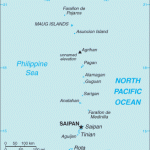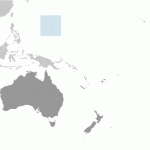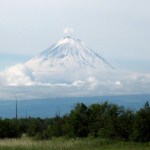Mariana Islands
Our tour of the Marianas begins SW of Guam. In this area the volcanoes are submerged and make up a region known as the Southern Seamount Province. Our first stop is Tracey Seamount, which lies 30 km west of Guam. Tracey is a ~2 km tall cone and volume of ~45 km3 It is one of the smaller volcanoes in the Mariana arc; Pagan, contains about 2200 km3 of material (Bloomer et al., 1989). It has a sector collapse on its western flank and resembles a submarine Mt. St. Helens. It was investigated by the ROV Hyper-Dolphin from the R/V Natsushima in Feb. 2009, which revealed that the cone is map up of…
This week I welcome Dr. Ed Kohut as a guest blogger here on Eruptions (while I am off in the Sierras doing some field work). I've known Ed for 10 years now - we were both graduate students in igneous petrology at Oregon State University - and we are both Massachusetts natives. Ed was in the Coast Guard before getting degrees at University of Rhode Island and Boston University before heading of to Oregon State for a Ph.D., where he worked on melt inclusions in minerals. One of his major research areas is magmatism in the Mariana Islands and he was nice enough to put together a look at the…
Mineral King valley in California.
Well, we are in the peak of the summer, so Eruptions will be running a bit of summer schedule while I'm off away from the interweb tubes. First off, from July 11-20, I'll be off in the mountains, doing some much-needed fieldwork with my (first) undergraduate research student. We'll be up in the Mineral King area of Sequoia National Park looking at some old rhyolites and granites - we're talking Triassic and Jurassic submarine and subaerial calderas! We'll hopefully be taking a look at zircons in these rocks to help constrain the timescales of these…
Have guests in town, so I'm a little busy, but you can hopefully keep entertained with the latest Smithsonian/USGS Global Volcanism Program Volcanic Activity Report.
Chile's Melimoyu volcano.
The highlights (not including Taal and Eyjafjallajökull) include:
Alaska's Cleveland volcano has been reduced to and alert status of "unassigned" (used when a volcano is not closely monitored so AVO doesn't know what exactly is "background") after a few weeks of activity. The same was done for the submarine volcano south of Sarigan in the Marianas Islands after no signs of activity since the eruption…
The level of news-frenzy on some of the recent volcanic eruptions has died down, but if you're looking to see information on the many rumbling going on worldwide, look no further. Here is this week's Volcanic Activity Report put together by Sally Kuhn Sennert of the Global Volcanism Program.
Highlights - not including Pacaya, Yasur, Tungurahua and our friend in Iceland - include:
The eruption in the Marianas apparently came from South Sarigan volcano - at least according to the best guess by folks who work in the Marianas. This submarine volcano apparently shows evidence of young lava flows…
Quick news on Memorial Day (in the US at least):
Ash soaked by rain from Tropical Storm Agatha on the roofs of homes in Guatemala after the late May eruption of Pacaya.
Sixteen scientists were evacuated from islands in the northern Marianas due to the eruption of the unnamed submarine volcano south of Sarigan Island. The eruption is continuing to be monitored closely by the USGS and National Weather Service as the plume - which is most steam with minor ash - could disrupt air traffic in/around Saipan. The latest USGS CNMI update:
Seismicity at a single nearby station on Sarigan Island…
Sarigan Island in the northern Mariana Islands. An undersea eruption appears to be underway south of the island.
Thanks to the watchful eye of Eruptions readers, we had an inkling of this eruption the other day, but now we have confirmation that an undersea eruption is underway in the northern Mariana Islands. The exact volcano erupting is unknown, but it appears to be between Anatahan and Sarigan (see below) - both active volcanoes in the Marianas - at a depth of 300 meters. The eruption has been described by the USGS as hot water vapor and an ash plume that might have reached as high as 12…
Catching up with some news:
Anatahan erupting in the northern Mariana Islands in 2003.
I ran across this article right before I got sick, but its been popping up around the interwebs (and is pretty interesting). It details a study in Molecular Ecology that suggests that populations of caribou in Canada's Yukon Territory were strongly effected by the White River Tephra. The White River Tephra is supposedly the largest Holocene plinian tephra (from a ash cloud fallout), with two components dating from ~1900 years ago and ~1250 years ago. The vent for the WRT is likely from a vent beneath the…
Here it is, my attempt to recap a year's worth of volcanic events. By no means is this supposed to capture every event, but rather the highlight/lowlights and what most captivated me during 2009. I'll be announcing the winner of the 2009 Pliny for Volcanic Event of the Year tomorrow.
Waimangu Geothermal Valley in New Zealand, taken in January 2009 by Erik Klemetti.
January
The year started out with a trip to New Zealand (well, for me at least) and vistas of the Waimangu Valley, formed in the 1886 eruption of Tarawera on the North Island. We were also still thinking about the late 2008…
Finals day for me, so I'll be grading grading grading ... but first, a little news:
The May 2009 eruption of West Mata. Image courtesy of NSF and NOAA.
I covered it in May, but the popular press is now all over the West Mata undersea eruption - mostly thanks to the media boost that AGU can give you. It is worth checking out the new articles on the eruption in the Lau Basin near the Marianas, mostly because of the nifty video of the eruption. In the video, you can clearly see both an explosive component of the eruption as gas "burps" out through a cooled carapace and a more effusive pillow…
Sarigan Island in the Marianas - your MVP #4.
I have to hand it to all of you, each time I've tried to make the Mystery Volcano Photo a challenge, you beat it with flying colors. The photo is, in fact, of Sarigan in the Mariana Islands (thanks to Dr. Ed Kohut for providing the photo). Eruptions reader Cam got the volcano on the second guess, leaving our current standings at:
MVP Standings
volcanista - 1
Ralph - 1
Elizabeth - 1
Cam - 1
everybody else - 0
Not much is known about Sarigan - it is an island composite volcano in the Mariana Islands. The last few eruptions have produced lava dome…
Busy today with scouting out some field location for the class I'll be teaching this fall. Here's this week's USGS/SI Weekly Volcano Report. The report is a little more eventful than last week's, so enjoy!
Kliuchevskoi Volcano in Kamchatka, taken summer of 2009 by Theresa Kayzar.
Highlights include:
Three volcanoes on the Kamchatka Peninsula are currently producing ash plumes: Kliuchevskoi, Koryaksky and Shiveluch. Shiveluch has been having the most intense eruptions, but the former two are both producing ash-and-steam plumes that reach over 3 km / 10,000 feet.
Talang in Indonesia saws its…
A week's worth of volcano news in one sitting, thanks to the USGS and Smithsonian Inst.'s Global Volcanism Program.
Thanks again, Sally Kuhn Sennert for putting it together!
This week's highlights include:
Small ash column spotted at Manam, Papua New Guinea. We talked about Manam not too long ago.
More details of the ongoing submarine eruption at West Mata in the Mariana Islands.
The lava dome continues to grow on Redoubt, Alaska with no real collapse yet.
Pilots spotted small (2.1 km / 7,000 foot) steam/ash plumes at Suwanosejima, Japan.
5-6 km / 18-25,000 foot ash plumes were produced by…
Things are busy - both volcanically and personally - so I'm going to just give you some links to a bunch of exciting/interesting/insane news:
West Mata erupting on May 5, 2009 in the Lau Basin.
According to a bunch of news sources, the eruption at Fernandina in the Galapagos is over (in spanish). That being said, the PNG noted that there is still a lot of carbon dioxide and sulfur dioxide being emitted, suggesting there is still a lot of degassing magma beneath the vents - at what depth (and will it erupt) is the question.
There is a lot of speculation that Nyiragongo (DRC) is erupting or…
Some brief tidbits from the volcanic realms:
Active volcanism at NW Rota-1
Kilauea? Explosive? You might think of Kilauea as a volcano that generates impressive Hawaiian-style eruptions with fire fountains reaching 100s m and dazzling lava flows, but Don Swanson at HVO sees evidence of a big explosive event at Kilauea. This eruption was ~1,000-1,600 years ago and may have produced a plinian-scale eruptive column and threw cm-scale chunks up to 17 km from the vent.
The intermingling of life and active volcanism always seems counterintuitive, but when you're talking undersea volcanism, all…
Mount Pagan in the Mariana Islands erupting on April 15, 2009. Image courtesy of the NASA Earth Observatory.
Up until fairly recently, a lot of volcanoes got away with erupting without anyone knowing the better. However, with all the "eyes in the sky" we have these days, even remote oceanic volcanoes get caught in the act of erupting. Case in point is this image (above) of Mt. Pagan in the Mariana Islands erupting. It was captured by the MODIS satellite yesterday and it shows a health ash plume emanating from the volcano. Pagan is an oceanic stratovolcano on the sparsely populated island of…
For those of you interested in what happens in the realm of submarine volcanism, I can pass on some tidbits I've gotten about NW-Rota 1, a submarine volcano in the Mariana Islands (see bathymetry above). Dr. Ed Kohut (Petrogenex), a friend of mine from my days at Oregon State Univ., is currently on a JAMSTEC research cruise in the Mariana Islands, visiting the area about NW Rota-1. He reports:
"We just reached NW-Rota 1. It is still actively erupting. To put that in perspective, it has been observed erupting every time it has been visited since 2003. Today's actvity is not as…


